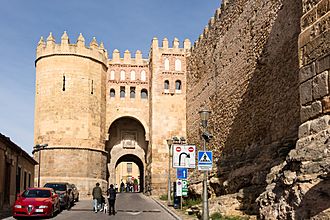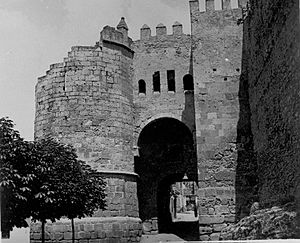Puerta de San Andrés (Segovia) facts for kids
Quick facts for kids Puerta de San Andrés |
|
|---|---|

View of the Puerta de San Andrés
|
|
| Alternative names | Puerta de la Judería Puerta del Socorro |
| General information | |
| Status | Intact |
| Type | City gate |
| Location | Segovia, Castile and León, Spain |
| Coordinates | 40°56′59.20″N 4°7′37.71″W / 40.9497778°N 4.1271417°W |
| Completed | c. 15th century |
| Design and construction | |
| Architect | Juan Guas (possibly) |
The Puerta de San Andrés is a historic city gate located in Segovia, Spain. Its name means "Gate of Saint Andrew" in Spanish. This gate is an important part of Segovia's old medieval walls, which once protected the city.
Today, the Puerta de San Andrés is recognized as a Bien de Interés Cultural. This means it is a very important historical site in Spain, protected by law because of its cultural value.
What is the Puerta de San Andrés?
This famous gate is also known by other names, like Puerta de la Judería or Puerta del Socorro. You can find it on the south side of the ancient walls of Segovia.
The gate has two strong towers. One tower is square-shaped, and the other has many sides, making it polygonal. It also features a large arch for people to pass through. You can see irregular windows, small openings called loopholes (used for defense), and decorative edges called cornices. The top of the gate has pyramid-shaped battlements and special shields with symbols, known as heraldic shields.
The Puerta de San Andrés was built in a very smart spot. It overlooks the Río Clamores, a river that would have helped protect the city long ago. Some historians believe that a skilled builder named Juan Guas might have helped design or construct this gate.
History and Restoration
Towards the end of the 1800s, the polygonal tower of the gate started to fall apart. Part of it had collapsed, and it remained in ruins even until the mid-1900s. Luckily, the gate was later carefully restored. Workers brought it back to its original appearance, so we can see it as it was meant to be.
In 1931, the Puerta de San Andrés was officially declared a Monumento Histórico-Artístico. This special title means it was recognized as a historical and artistic monument. The decision was made by the government at the time. Niceto Alcalá-Zamora, who was the head of the government, and Marcelino Domingo, the Minister of Public Instruction and Fine Arts, signed the decree.
Today, the gate continues to be an important landmark in Segovia. It stands as a reminder of the city's rich history and its strong medieval defenses.
See also
 In Spanish: Puerta de San Andrés para niños
In Spanish: Puerta de San Andrés para niños


